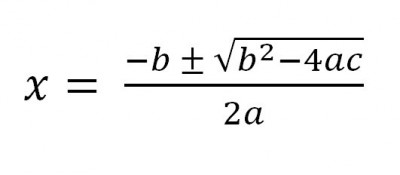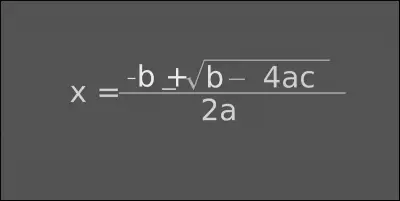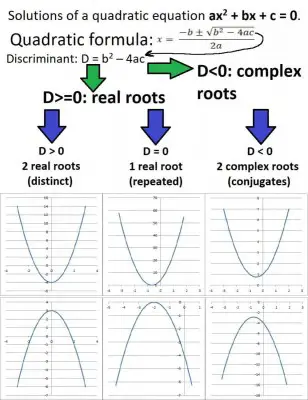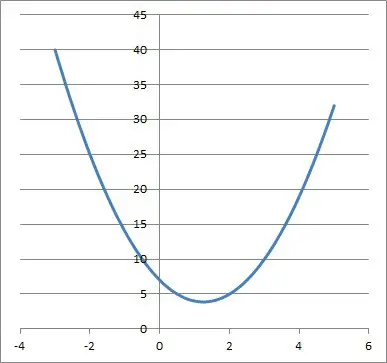The quadratic formula is used often in algebra to solve quadratic equations and in calculus to find zeros of first or second derivatives. However, it helps to be familiar with how the proof works so you know where the formula comes from.
So, what is the quadratic formula proof? First, divide both sides by a to get a monic quadratic equation x2 + (b/a)x + (c/a). Subtract c/a from both sides, and then complete the square. Factor one side and take the square root of both sides. Finally, subtract b/2a from both sides and do some simplification to get the quadratic formula.
This means that the quadratic formula is really a shortcut for completing the square to solve a given quadratic equation.
In this article, we’ll show the quadratic formula proof with detailed steps. We’ll also talk about the discriminant and how it can tell us about the types of solutions we will get for a quadratic equation.
Let’s get started.
Quadratic Formula Proof
Here is a derivation to prove that the quadratic formula really does give us solutions for a quadratic equation. The proof hinges upon completing the square.

First, remember that a quadratic equation has the standard form
- ax2 + bx + c = 0
where a, b, and c are real numbers, and a is not zero.
Step 1 is to turn the quadratic into a monic polynomial (which means that it will have a leading coefficient of 1). To do this, divide both sides by a:
- (ax2 + bx + c) / a = 0 / a
- x2 + (b/a)x + (c/a) = 0
The result is a monic quadratic equation in standard form.
Step 2 is to replace b/a by B and c/a by C to make our calculations easier:
- x2 + (b/a)x + (c/a) = 0
- x2 + Bx + (c/a) = 0 [replace b/a by B]
- x2 + Bx + C = 0 [replace c/a by C]
(We will keep these substitutions in mind and change back to b, c near the end of the proof).
Step 3 is to subtract the constant coefficient C from both sides of the equation:
- x2 + Bx + C = 0
- x2 + Bx + C – C = 0 – C [subtract C from both sides]
- x2 + Bx = -C
Note that the equation is no longer in standard form. However, this will set us up for completing the square in the next step.
Step 4 is to complete the square. Remember that to complete the square for the left side (x2 + Bx), we take half of the x coefficient (that is, B/2) and then square it to get (B/2)2 = B2/4.
We add this constant value to both sides to keep the equation balanced:
- x2 + Bx = -C
- x2 + Bx + (B2/4) = -C + (B2/4) [add B2/4 to both sides to complete the square]
Step 5 is to factor the left side as a perfect square trinomial:
- x2 + Bx + (B2/4) = -C + (B2/4)
- (x + (B/2))2 = -C + (B2/4) [factor as a perfect square trinomial]
Step 6 is to take the square root of both sides of the equation. We will take a + or – to preserve the two possible solutions:
- (x + (B/2))2 = -C + (B2/4)
- √(x + (B/2))2 = ±√(-C + (B2/4)) [take the square root of both sides, ±]
- x + (B/2) = ±√(-C + (B2/4)) [the squared and square root on the left cancel]
Step 7 is to subtract B/2 from both sides to isolate x:
- x + (B/2) = ±√(-C + (B2/4))
- x + (B/2) – (B/2) = ±√(-C + (B2/4)) – (B/2)
- x = ±√(-C + (B2/4)) – (B/2)
- x = (-B/2) ±√(-C + (B2/4))
Step 8 is to replace B by b/a and C by c/a, which is the opposite of the substitution we made in step 2:
- x = (-B/2) ±√(-C + (B2/4))
- x = (-(b/a)/2) ±√(-c/a + ((b/a)2/4)) [replace B by b/a and C by c/a]
- x = (-b/2a) ±√(-c/a + (b2/4a2)) [simplify]
- x = (-b/2a) ±√((-4ac/4a2) + (b2/4a2)) [common denominator of 4a2 inside radical]
- x = (-b/2a) ±√((-4ac + b2)/4a2)) [combine terms with common denominator of 4a2 inside radical]
- x = (-b/2a) ±√(-4ac + b2)/√(4a2) [change radical of fraction into fraction of radicals]
- x = (-b/2a) ±√(-4ac + b2)/2a [√(4a2) = 2a]
- x = (-b/2a) ±√(b2 – 4ac)/2a [rearrange terms: -4ac + b2 = b2 – 4ac]
- x = [-b ± √(b2 – 4ac)] / 2a [combine terms with common denominator of 2a]
This is the form of the quadratic formula that we are familiar with.
Note that this method is a shortcut for completing the square for any given quadratic equation.
Discriminant Of A Quadratic Equation
The discriminant of a quadratic equation is the expression b2 – 4ac. Often, we use the letter D to stand for the discriminant, so D = b2 – 4ac.
In the quadratic formula, the discriminant is the expression under the radical symbol.

What Does The Discriminant Tell You?
The discriminant tells us what kind of solutions a quadratic equation has. The sign of the discriminant tell us what we need to know, and there are 3 distinct cases:
- Case 1: D > 0. Here, the discriminant is positive, and this occurs when b2 > 4ac. In this case, there are two distinct real solutions to the quadratic equation.
- Case 2: D = 0. Here, the discriminant is zero, and this occurs when b2 = 4ac. In this case, there is one repeated real solution (a double root) to the quadratic equation.
- Case 3: D < 0. Here, the discriminant is negative, and this occurs when b2 < 4ac. In this case, there are two complex conjugate solutions to the quadratic equation.
For each quadratic equation, we can draw the graph of the corresponding parabola. A parabola is the set of all of points in the xy-plane that satisfy a specific quadratic equation.
The discriminant also gives us some information about the parabola and what it looks like. In fact, the discriminant tells us whether the parabola intersects the x-axis (y = 0), and it also tells us how many such intersections occur.
Remember that the points where the parabola intersects the x-axis (y = 0) are the values of x that satisfy the quadratic equation when it is set equal to zero. These values are called roots or solutions of the quadratic equation.

To get the discriminant for the quadratic equation, take the expression under the radical in the quadratic formula.
To find the discriminant for specific quadratic coefficients a, b, and c, just substitute those values into the discriminant.
Example: How To Find The Discriminant
Let’s examine the quadratic equation 2x2 – 5x + 7 = 0.
This equation already has the standard form ax2 + bx + c = 0, with a = 2, b = -5, and c = 7.
The quadratic formula tells us that the expression for the discriminant is D = b2 – 4ac, so:
- D = b2 – 4ac
- D = (-5)2 – 4(2)(7)
- D = 25 – 56
- D = -31
In this case, our discriminant is D = -31. Since D < 0 (negative discriminant), we know that:
- There are two complex conjugate solutions to the quadratic equation (with no real solutions).
- The graph of the parabola will never intersect the x-axis (the parabola lies entirely above the x-axis, since a > 0).

You can learn more about the discriminant of a quadratic equation here.
Conclusion
Now you know the steps of the quadratic formula proof and why we take those steps. You also know what the discriminant is and why it is important in finding out the types of solutions a quadratic has.
I hope you found this article helpful. If so, please share it with someone who can use the information.
Don’t forget to subscribe to our YouTube channel & get updates on new math videos!



